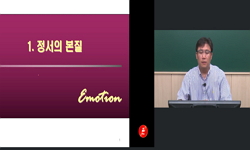이 연구는 회귀분석과 가상 정서 상황에서의 정서 표현 대상에 대한 인상 평가의 비교를 통해 한국의 대표적 선망 관련 정서인 "부러움"과 "시샘"이 가지는 사회적 기능의 차이를 탐색하였다...
http://chineseinput.net/에서 pinyin(병음)방식으로 중국어를 변환할 수 있습니다.
변환된 중국어를 복사하여 사용하시면 됩니다.
- 中文 을 입력하시려면 zhongwen을 입력하시고 space를누르시면됩니다.
- 北京 을 입력하시려면 beijing을 입력하시고 space를 누르시면 됩니다.

부러움: 연합과 접근의 동기를 알리는 전략적 커뮤니케이션 = Buroum: An Emotion Strategically Communicating Association and Approach Motives
한글로보기https://www.riss.kr/link?id=A104030435
-
저자
차운아 (중앙대학교)

- 발행기관
- 학술지명
- 권호사항
-
발행연도
2010
-
작성언어
Korean
-
주제어
정서 ; 선망 ; 부러움 ; 시샘 ; 감탄 ; 사회비교 ; 접근 동기 ; emotion ; envy ; Buroum ; Sisem ; admiration ; social comparison ; approach motive
-
등재정보
KCI등재
-
자료형태
학술저널
- 발행기관 URL
-
수록면
51-72(22쪽)
-
KCI 피인용횟수
11
- DOI식별코드
- 제공처
- 소장기관
-
0
상세조회 -
0
다운로드
부가정보
국문 초록 (Abstract)
이 연구는 회귀분석과 가상 정서 상황에서의 정서 표현 대상에 대한 인상 평가의 비교를 통해 한국의 대표적 선망 관련 정서인 "부러움"과 "시샘"이 가지는 사회적 기능의 차이를 탐색하였다. 구체적으로 부러움이 시샘에 비해 상향 사회비교 대상에 대한 심리적 거리를 좁히고 다가가고자 하는 동기와 관련을 가지는지, 특히 정서 표현을 통해 이러한 사회적 동기를 신호하는 것이 가능한지를 살펴보고자 하였다. 연구 결과 사회비교 지향 성향이 높을수록 부러움을 많이 경험하였으며 부러움을 표현한 대상에 대해서는 시샘을 표현한 대상에 비해 우월함을 인정하면서도 심리적 거리를 가깝게 느끼고 호감을 보이는 것으로 나타났다. 이러한 결과는 시샘이 상향 사회 비교 상황 중에서도 심리적 거리가 멀거나 가깝게 지낼 필요가 없는 사람에 대해 느끼는 ‘분리’ 혹은 ‘회피’의 정서인 데 비해, 부러움은 가까운 혹은 가깝게 지낼 필요가 있는 대상에 대해 갖게 되는 ‘연합’ 혹은 ‘접근’의 정서임을 보여준다.
다국어 초록 (Multilingual Abstract)
This study examined social functions of two envy-related emotions in Korea: Buroum (benign envy) and sisem (malicious envy). Although these two emotions might share some common features as members of envy family,it was hypothesized that they are assoc...
This study examined social functions of two envy-related emotions in Korea: Buroum (benign envy) and sisem (malicious envy). Although these two emotions might share some common features as members of envy family,it was hypothesized that they are associated with solving different social problems and thus serve different social functions. The results showed that buroum was uniquely predicted by high level of social comparison orientation and low level of prevention motives. In addition, experience of being envied in terms of buroum, compared to that in terms of sisem, evoked greater eciprocal sense of closeness and desire to be close with the person who envied. These findings suggest that experience of sisem is associated with and is based on ‘separation' or ‘avoidance’ motives and serves a social function of balancing unjustified unfairness whereas the experience of buroum is associated with and is based on ‘association' or ‘approach' motives and serves a social function of managing interpersonal harmony and strengthening social ties in collectivist and interdependent cultures.
참고문헌 (Reference)
1 박인조, "한국어 감정단어의 목록과 정서 차원 탐색" 한국사회및성격심리학회 19 (19): 71-100, 2005
2 국립국어원, "표준국어대사전"
3 한덕웅, "사회비교의 목표와 성공/실패 경험에 따른 비교 대상의 선택" 13 : 311-329, 1999
4 장은영, "비교 대상의 선택에서 환류유형, 비교속성 및 통제력의 효과" 13 : 201-217, 1999
5 차운아, "부러움:한국의 “무해한 선망”" 한국사회및성격심리학회 23 (23): 171-189, 2009
6 Algoe, S. B., "Witnessing excellence in action: the 'other-praising' emotions of elevation, gratitude, and admiration" 4 : 105-127, 2009
7 Frijda, N. H., "The social roles and functions of emotions. in: Emotion and culture: Empirical Studies of Mutual Influenced" American Psychological Association 51-87, 1994
8 Silver, M., "The perception of envy" 41 : 105-117, 1978
9 Darwin, C., "The expression of the emotions in man and animals: Definitive edition" Oxford University Press 1998
10 Parrott, W. G., "The emotional experiences of envy and jealousy. in: The psychology of jealousy and envy" Guilford 3-30, 1991
1 박인조, "한국어 감정단어의 목록과 정서 차원 탐색" 한국사회및성격심리학회 19 (19): 71-100, 2005
2 국립국어원, "표준국어대사전"
3 한덕웅, "사회비교의 목표와 성공/실패 경험에 따른 비교 대상의 선택" 13 : 311-329, 1999
4 장은영, "비교 대상의 선택에서 환류유형, 비교속성 및 통제력의 효과" 13 : 201-217, 1999
5 차운아, "부러움:한국의 “무해한 선망”" 한국사회및성격심리학회 23 (23): 171-189, 2009
6 Algoe, S. B., "Witnessing excellence in action: the 'other-praising' emotions of elevation, gratitude, and admiration" 4 : 105-127, 2009
7 Frijda, N. H., "The social roles and functions of emotions. in: Emotion and culture: Empirical Studies of Mutual Influenced" American Psychological Association 51-87, 1994
8 Silver, M., "The perception of envy" 41 : 105-117, 1978
9 Darwin, C., "The expression of the emotions in man and animals: Definitive edition" Oxford University Press 1998
10 Parrott, W. G., "The emotional experiences of envy and jealousy. in: The psychology of jealousy and envy" Guilford 3-30, 1991
11 Ortony, A., "The cognitive structure of emotion" Cambridge University Press 1988
12 Foster, G. M., "The anatomy of envy: A study in symbolic behavior" 13 : 165-202, 1972
13 Fiske, A. P., "Structures of social life" Free Press 1991
14 Keltner, D., "Social functions of emotions. in: Emotions: Current Issues and Future Directions" Guilford Press 192-213, 2001
15 Keltner, D., "Social functions of emotions at four levels of analysis" 13 : 515-521, 1999
16 Suls, J., "Social comparison: Why, with whom and with what effect?" 11 : 159-163, 2002
17 Higgins, E. T., "Promotion and prevention: Regulatory focus as a motivational principle. in: Advances in Experimental Social Psychology. Vol. 30" Academic Press 1-46, 1998
18 Doi, T., "On the concept of Amae" 13 : 7-11, 1992
19 Yamaguchi, S., "Nichijougo to shiteno Amae kara kangaeru [Thinking Amae from everyday usage of the word]. in: Amae ni tsuite kangaeru [Thinking about Amae]" Seiwa Shoten 1999
20 Veccio, R. P., "Negative emotion in the workplace: Employee jealousy and envy" 7 : 161-179, 2000
21 Lockwood, P., "Motivation by positive or negative role models: Regulatory focus determines who will best inspire us" 83 : 854-864, 2002
22 Diener, E., Fujita, E., & Seidlitz, L., "Manual for the intensity and time affect survey(ITAS).Unpublished manuscript" University of Illinois at Urbana-Champaign 1991
23 Dogan, K., "Managing envy and jealousy in the workplace" 33 : 57-64, 2001
24 Van de Ven, N., "Leveling up and down: The experience of malicious and benign envy" 9 : 419-429, 2009
25 Gibbons, F. X., "Individual differences in social comparison: Development of a scale of social comparison orientation" 76 : 129-142, 1999
26 Copeland, L., "Going international: How to make friends and deal effectively in the global market place" Random House 1986
27 Veccio, R. P., "Explorations in employee envy: Feeling envious and feeling envied" 19 : 69-81, 2005
28 Keltner, D., "Emotion, social function, and psychopathology" 2 : 320-342, 1998
29 Cohen-Charash, Y., "Does perceived unfairness exacerbate or mitigate interpersonal counterproductive work behaviors related to envy?" 92 : 666-680, 2007
30 Maruta, T., "Does an American puppy Amaeru? A comment on Dr. Doi’s paper" 13 : 12-17, 1992
31 Parrott, W. G., "Distinguishing the experiences of envy and jealousy" 64 : 906-920, 1993
32 Smith, R. H., "Dispositional envy" 25 : 1007-1020, 1999
33 Niiya, Y., "Converging evidence on the meaning of amae among Japanese" 2000
34 Smith, R. H., "Comprehending envy" 133 : 46-64, 2007
35 Schaubroeck, J., "Comparing lots before and after: Promotion rejectees' invidious reactions to promotees" 94 : 33-47, 2004
36 Higgins, E. T., "Beyond pleasure and pain" 52 : 1280-1300, 1997
37 Hall, E. T., "Beyond culture" Anchor Press 1976
38 Niiya, Y., "Amae in Japan and the United States: An exploration of a “culturally unique” emotion" 6 : 279-295, 2006
39 Festinger, L., "A theory of social comparison processes" 7 : 117-140, 1954
동일학술지(권/호) 다른 논문
-
신뢰로운 얼굴이 투자결정에 미치는 영향: 눈, 코, 입의 영향 비교
- 한국사회및성격심리학회
- 이용실
- 2010
- KCI등재
-
과학적 내용분석(SCAN)의 타당성: SCAN의 준거가 진술서 내 거짓 구역을 탐지하는 정확성을 근거로
- 한국사회및성격심리학회
- 김시업
- 2010
- KCI등재
-
목격자 진술에 대한 SCAN(Scientific Content Analysis, 과학적 내용 분석) 기법의 타당성 연구
- 한국사회및성격심리학회
- 이재웅
- 2010
- KCI등재
-
- 한국사회및성격심리학회
- 홍기원
- 2010
- KCI등재
분석정보
인용정보 인용지수 설명보기
학술지 이력
| 연월일 | 이력구분 | 이력상세 | 등재구분 |
|---|---|---|---|
| 2020 | 평가예정 | 계속평가 신청대상 (등재유지) | |
| 2015-01-01 | 평가 | 우수등재학술지 선정 (계속평가) | |
| 2011-01-01 | 평가 | 등재학술지 유지 (등재유지) |  |
| 2009-01-01 | 평가 | 등재학술지 유지 (등재유지) |  |
| 2007-01-01 | 평가 | 등재학술지 유지 (등재유지) |  |
| 2005-01-01 | 평가 | 등재학술지 유지 (등재유지) |  |
| 2002-01-01 | 평가 | 등재학술지 선정 (등재후보2차) |  |
| 2000-01-01 | 평가 | 등재후보학술지 선정 (신규평가) |  |
학술지 인용정보
| 기준연도 | WOS-KCI 통합IF(2년) | KCIF(2년) | KCIF(3년) |
|---|---|---|---|
| 2016 | 1.16 | 1.16 | 0.95 |
| KCIF(4년) | KCIF(5년) | 중심성지수(3년) | 즉시성지수 |
| 0.96 | 1.58 | 1.54 | 0.4 |




 KCI
KCI







